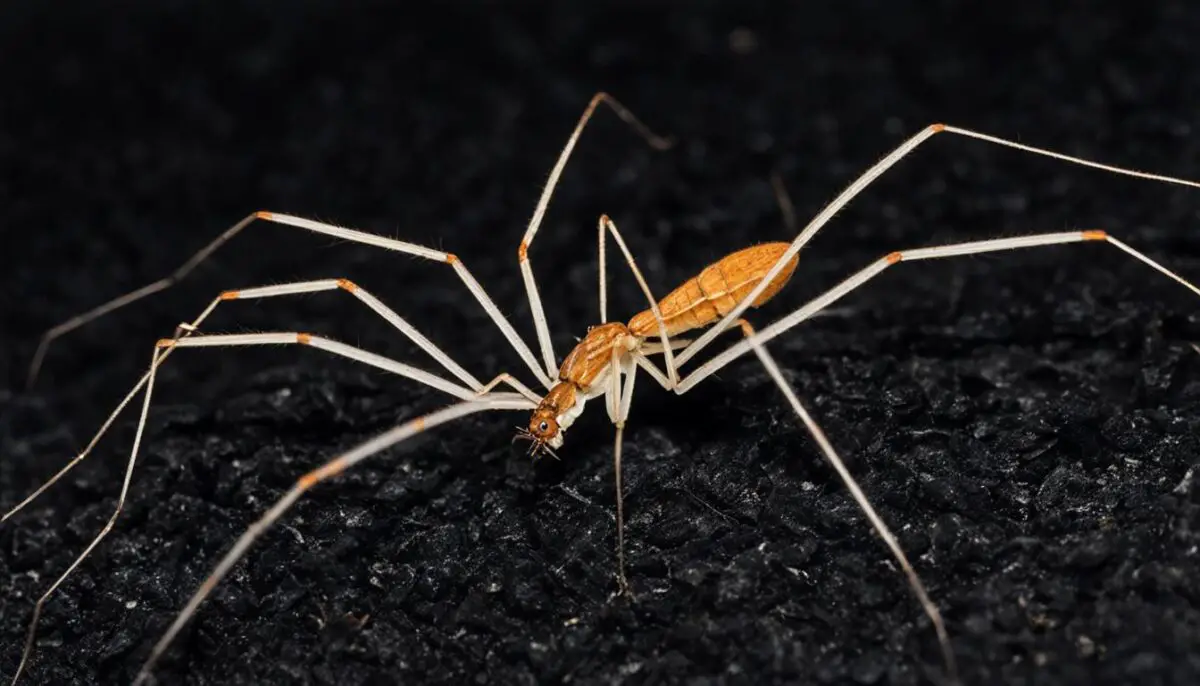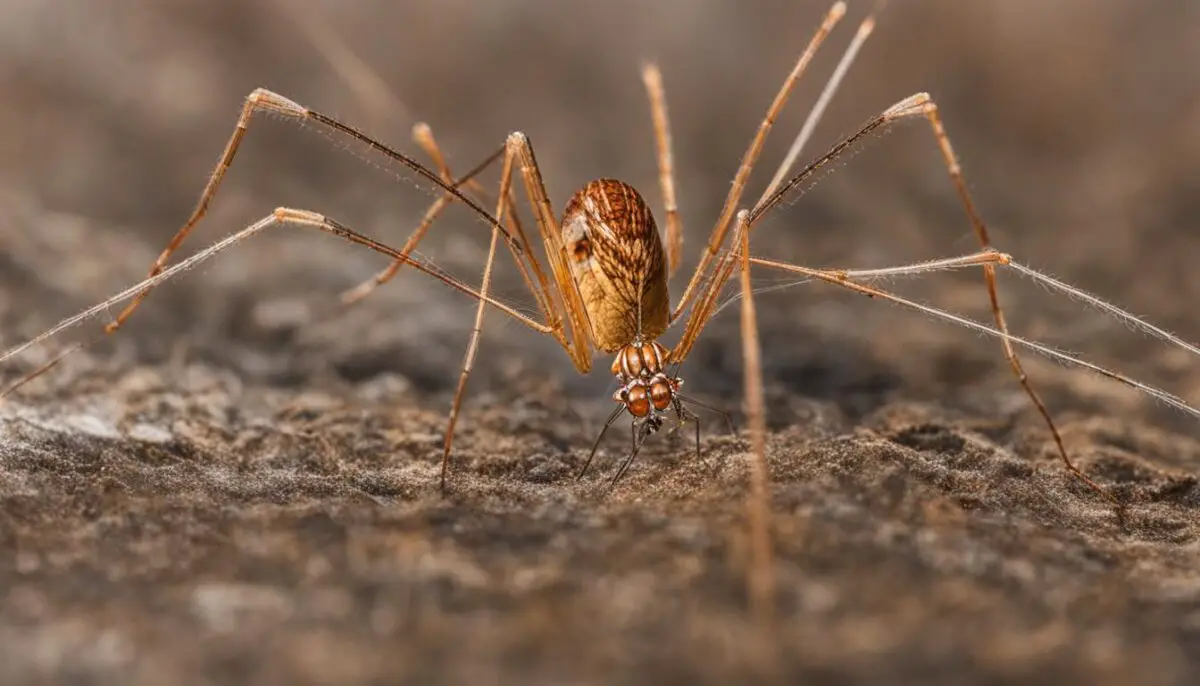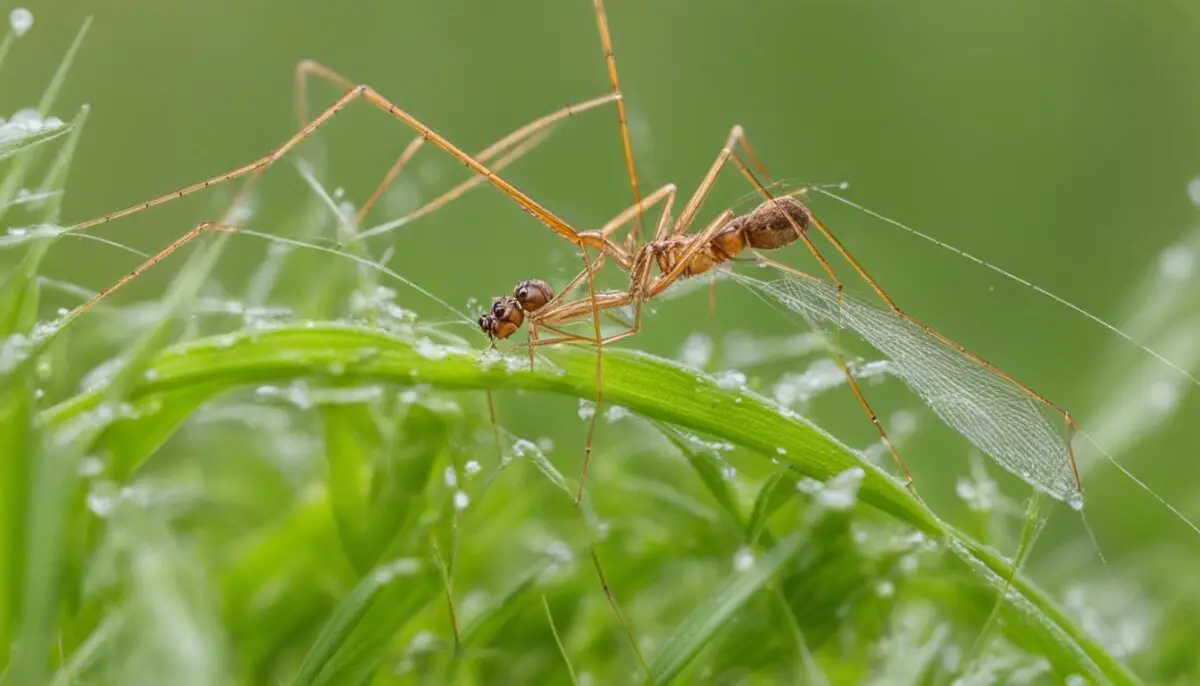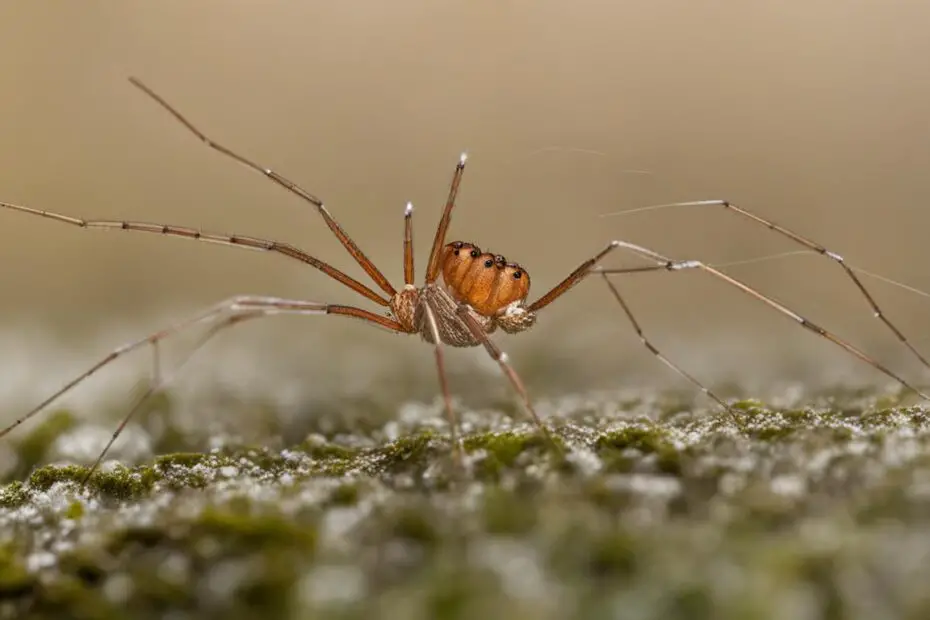Are you curious about the physical appearance of daddy long legs? Also known as harvestmen, these unique creatures often get mistaken for spiders. Let’s decode their appearance and learn about their characteristics!
Daddy long legs have a distinct appearance that sets them apart. Their most noticeable feature is their long, spindly legs, which give them their name. These legs can measure up to 5 centimeters in length and are often banded or marked with chevron patterns.
Their small, oval-shaped bodies come in shades of brown or gray. One interesting characteristic of daddy long legs is their lack of a distinct waist, which differentiates them from spiders.
Key Takeaways:
- Daddy long legs have long, spindly legs and small, oval-shaped bodies.
- Their bodies are typically brown or gray, with banded or chevron markings on their legs.
- Daddy long legs lack a distinct waist, distinguishing them from spiders.
Daddy Long Legs Behavior
Daddy long legs have fascinating behavioral traits, especially when it comes to their movement. They have a high probability of losing a leg during their lifetime, and they have developed compensatory mechanisms to adapt to leg loss.
After losing one leg, daddy long legs exhibit a behavior called “stotting,” where they dribble their bodies on the ground with each stride. This unique movement pattern is thought to help them maintain balance and stability after the loss of a leg.
When daddy long legs lose two legs, they transition to a behavior called “bobbing.” During this movement, the vertical plane becomes more pronounced, with their body bobbing up and down. This irregular motion can make it difficult for predators to track them.
Daddy long legs also show signs of recovery in their movement abilities after a few days of leg loss. Although they never fully regenerate the lost leg, they can adjust their gait and adapt to their new circumstances.
Overall, the behavior of daddy long legs showcases their remarkable ability to adapt to leg loss and continue their locomotion in unique and effective ways.

Adaptations to Leg Loss in Daddy Long Legs
| Leg Loss | Behavior |
|---|---|
| One leg | Stotting – dribbling bodies on the ground with each stride |
| Two legs | Bobbing – vertical plane of movement becomes more pronounced |
| Recovery | Adjustment of gait and adaptation to new circumstances |
Different Types of Daddy Long Legs
Daddy long legs belong to the arachnid order Opiliones and are classified into various species. Some commonly known species include the Pholcus phalangioides, also known as the cellar spider, and the Pholcidae family. There are also several other species of harvestmen that are referred to as daddy long legs, especially in different regions. Each species may have slight variations in appearance, behavior, and habitat preferences, but they all share the common characteristic of having long, thin legs and elongated bodies.
Here are a few examples of daddy long legs species:
- Pholcus phalangioides (Cellar Spider)
- Opilio parietinus (Red-legged Harvestman)
- Leiobunum rotundum (Woodlouse Hunter)
These are just a few examples, and there are many more species of daddy long legs found worldwide.

Fascinating Varieties
Although daddy long legs share similar physical characteristics, there is a fascinating variety among the species. Some daddy long legs have intricate patterns and markings on their bodies, while others have a more uniform coloration. The lengths of their legs can also differ, with some species having relatively shorter legs compared to others. These variations add to the diversity and intrigue of these arachnids.
Did you know? Despite often being referred to as daddy long legs, the species Pholcus phalangioides actually belongs to the cellar spider family and not the true daddy long legs family (Pholcidae).
Daddy Long Legs Habitat
Daddy long legs, also known as harvestmen, can be found in various habitats around the world, excluding Antarctica. These adaptable creatures have the ability to thrive in different environments, which contributes to their widespread distribution.
Some species of daddy long legs prefer dark and damp areas, such as:
- Caves
- Under rocks
- Loose bark
- Abandoned burrows
Other species of daddy long legs may inhabit human dwellings, including:
- Cellars
- Attics
- High corners of buildings
“Daddy long legs are versatile and can adapt to a wide range of habitats, making them a common sight in various locations.”
The preferred environments of daddy long legs vary depending on the species, but they are often associated with dark and sheltered spaces, providing them with protection and suitable conditions for their survival.

| Preferred Environments: | Habitat Examples: |
|---|---|
| Dark and damp areas |
|
| Human dwellings |
|
“Understanding the preferred habitats of daddy long legs allows us to appreciate their adaptability and their ability to live alongside humans.”
Daddy Long Legs Diet
Daddy long legs, also known as harvestmen, have a diverse and opportunistic diet. They play an important role in controlling insect populations and contribute to the ecological balance of their habitat.
These fascinating arachnids primarily feed on small insects such as flies, mosquitoes, and spiders. The abundance of these insects makes them a readily available food source for daddy long legs.
Daddy long legs are also known to prey on other arthropods, including their own kind, and even small invertebrates like worms. This opportunistic feeding behavior enables them to adapt to various food resources and ensures their survival in different environments.
“Daddy long legs are voracious feeders, making them valuable contributors to the insect population control.”
One interesting feeding behavior observed in daddy long legs, particularly in the cellar spider species, is their invasion of other spider webs. They feed on the host spider, its eggs, or its captured prey, taking advantage of the resources available in the web.
The dietary preferences of daddy long legs make them efficient predators in their ecosystem. By consuming small insects and other arthropods, they help to maintain the balance of insect populations, preventing any uncontrolled growth that could disrupt the ecological harmony.
To summarize, daddy long legs have a varied diet consisting mainly of small insects, but they are also opportunistic feeders that can consume other arthropods and small invertebrates. Their feeding habits contribute to the natural control of insect populations, making them an essential component of their ecosystems.
| Food Preferences of Daddy Long Legs | Example |
|---|---|
| Small Insects | Flies, mosquitoes, spiders |
| Other Arthropods | Harvestmen, other spiders |
| Small Invertebrates | Worms |

Misconceptions About Daddy Long Legs
Despite their harmless nature, daddy long legs, also known as harvestmen, have been associated with various misconceptions and myths. Let’s address some of the most common misconceptions about these intriguing arachnids:
-
Myth: Daddy long legs are venomous and pose a threat to humans.
This is a prevailing myth surrounding daddy long legs. While it is true that some species have venom glands, their venom is not harmful to humans. Daddy long legs lack the ability to penetrate human skin with their fangs, and they are not known to bite or cause any medical harm.
-
Myth: Daddy long legs have the most potent venom of any spider.
This is another common misconception about daddy long legs. The notion that they possess extremely potent venom is not supported by scientific evidence. In reality, their venom is relatively weak compared to venomous spiders like black widows or brown recluses.
-
Myth: Daddy long legs are spiders.
While they may resemble spiders due to their long legs, daddy long legs are not true spiders. They belong to the order Opiliones and have distinct characteristics that separate them from spiders.
It’s important to dispel these misconceptions and understand the true nature of daddy long legs. By doing so, we can appreciate and coexist with these harmless creatures.

Daddy Long Legs and Humans
Daddy long legs are fascinating creatures that often find their way into our homes and outdoor spaces. While their spindly appearance may startle some individuals, it’s important to remember that daddy long legs are harmless and pose no threat to humans.
These gentle arachnids can actually be quite beneficial in our environment. Daddy long legs play a crucial role in controlling populations of other insects like mosquitoes and flies, helping to keep their numbers in check. So, encountering daddy long legs in your surroundings can actually be a sign of a natural pest control system at work.
If you happen to find a daddy long leg indoors, there’s no need to panic. You can easily and safely capture them by gently cupping your hand over them and then releasing them back into their natural habitat outside. By doing so, you not only show respect for these creatures but also contribute to the maintenance of ecological balance.
“Encountering daddy long legs is a reminder of the delicate balance of nature and the interconnectedness of all living organisms.”
Understanding and appreciating these interactions with daddy long legs can help cultivate a sense of harmony between humans and the natural world around us. So next time you come across a daddy long leg, take a moment to observe their graceful movements and marvel at the wonder of nature’s intricate web of life.
Conclusion
Daddy long legs are fascinating creatures that possess unique characteristics. With their distinct appearance, characterized by long, thin legs and small bodies, they stand out in the arachnid world. Their behavior, including their remarkable adaptations to leg loss, provides a captivating subject for study.
These intriguing creatures can be found in various habitats, showcasing their adaptability and wide-ranging distribution. Daddy long legs have a diverse diet, consisting of small insects and other arthropods. They play a beneficial role in controlling insect populations, making them valuable contributors to the natural ecosystem.
Despite common misconceptions, daddy long legs are harmless to humans. They do not pose any threat and can even be considered beneficial creatures. By understanding and appreciating the true nature of daddy long legs, we can gain a deeper appreciation for the intricate world of arachnids.
FAQ
What do daddy long legs look like?
Daddy long legs have long, spindly legs and small, oval-shaped bodies. They vary in size, ranging from a few millimeters to 5 centimeters in length. Their bodies are typically brown or gray in color, and they may have banded or chevron markings. Unlike spiders, they lack a distinct waist.
How do daddy long legs move?
Daddy long legs have fascinating behavior when it comes to movement. They have a high probability of losing a leg during their lifetime. After losing a leg, they exhibit a behavior called “stotting,” where they dribble their bodies on the ground with each stride. When they lose two legs, they transition to a behavior called “bobbing,” where the vertical plane of movement becomes more pronounced. They also show some recovery in their movement abilities after a few days of losing a leg.
What are the different types of daddy long legs?
Daddy long legs belong to the arachnid order Opiliones. Some commonly known species include the Pholcus phalangioides, also known as the cellar spider, and the Pholcidae family. There are several other species of harvestmen that are referred to as daddy long legs in different regions. Each species may have slight variations in appearance, behavior, and habitat preferences.
Where do daddy long legs live?
Daddy long legs can be found in various habitats around the world, except in Antarctica. Some species prefer dark and damp areas such as caves, under rocks, loose bark, and abandoned burrows. Others may inhabit human dwellings like cellars, attics, and high corners of buildings. They are adaptable creatures and can thrive in different environments.
What do daddy long legs eat?
Daddy long legs are opportunistic feeders and have a varied diet. They primarily consume small insects, including flies, mosquitoes, and spiders. They may also feed on other arthropods such as harvestmen and small invertebrates like worms. In some cases, daddy long legs invade the webs of other spiders to feed on the host spider, its eggs, or its prey.
Are daddy long legs venomous?
No, daddy long legs are not venomous and do not pose a threat to humans. While some species have venom glands, their venom is not harmful to humans. Their fangs are not capable of puncturing human skin, and they are not known to bite or cause any medical harm.
What is the interaction between daddy long legs and humans?
Daddy long legs are harmless to humans and play a beneficial role in controlling insect populations. If they are found indoors, they can be gently captured and released back into their natural habitat. It’s important to understand that these creatures are part of the natural ecosystem and contribute to maintaining ecological balance.
Can daddy long legs be found in homes and outdoor spaces?
Yes, daddy long legs are often encountered by humans in their homes and outdoor spaces. While they may startle some individuals, they are harmless and do not pose any threat to humans. In fact, they can be considered beneficial as they help control populations of other insects like mosquitoes and flies.
What are the key characteristics of daddy long legs?
Daddy long legs have a unique appearance with long, spindly legs and small, oval-shaped bodies. They exhibit fascinating behaviors when it comes to movement and adaptation to leg loss. They belong to the arachnid order Opiliones and are classified into various species. Daddy long legs can be found in various habitats around the world, except in Antarctica. They have a varied diet and are beneficial in controlling insect populations. It’s important to dispel misconceptions about their venom and understand their true nature.
